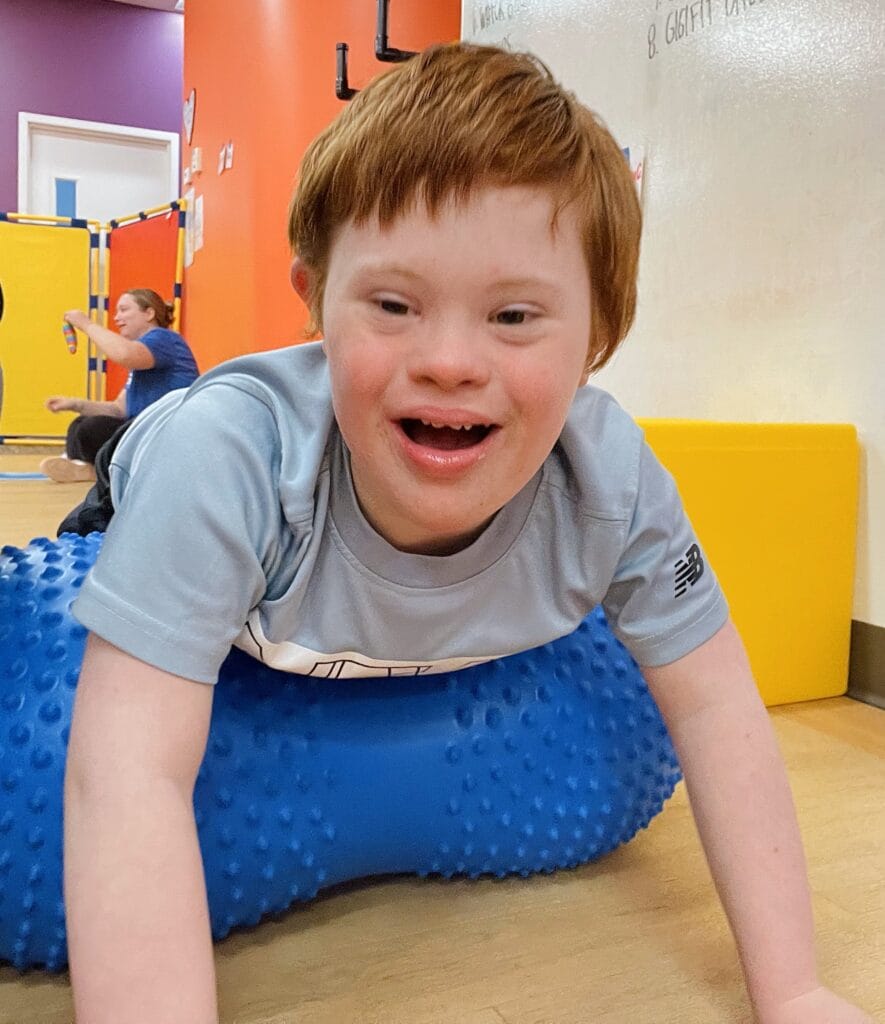Sensory Superstars: Strategies for Mastering Sensory Processing Challenges by Madi Pearl, S/OT
Imagine a world where the tags on your clothes feel like pinpricks, the hair dryer sounds like a front row seat at a concert, or the lighting in the room feels like a fluorescent spotlight shining directly into your eyes. For some, this is their normal everyday experience. Sensory Processing Disorder (SPD) can make everyday sounds, textures, lights, and movements extremely overwhelming or discomforting. Understanding SPD is the first step in assisting your child to feel seen and understood in a world that may often feel like too much.

What is Sensory Processing?
“Sensory processing involves the collection, integration, and interpretation from multiple sensory systems, including touch, movement, joint position, visual, auditory, smell, and taste” (Baumer & O’Neill, 2022).
What is Sensory Processing Disorder?
Sensory Processing Disorder, or SPD, occurs when the brain has difficulty processing sensory signals, resulting in disruptions within their everyday lives including self-care, academics, and social skills (Foster, 2013). SPD looks different for every individual and can affect one or more of the body’s internal senses (Foster, 2013).
.
Our Body’s Senses
Contrary to what we were taught in elementary school, our body has 8 different sensory systems!
Visual – Responsible for seeing. Including color, shape, orientation, motion.
Auditory – Responsible for hearing. Processes different sound frequencies.
Tactile – Responsible for processing touch. This includes texture, shape, size, weight, etc.
Gustatory – Responsible for processing taste. This system allows for discrimination between safe and harmful foods.
Olfactory – Responsible for processing smell. Allows us to detect and discriminate between odors.
Proprioceptive – Provides input from our muscles and joints. Allows our body to determine where it is in space (Pearce, 2024).
Vestibular – Provides our brain with information about motion, head position, and spatial awareness. Very important for balance and smooth, purposeful movements (Murphy, 2024).
Interoception – The ability to sense internal signals from your body. Examples include noticing when you are hungry or thirsty, determining the need to use the restroom, etc (Barker et al., 2021).
Hyper or Hypo?
When it comes to processing our senses, individuals can experience hypersensitivity and/or hyposensitivity. This can also vary depending on which sensory system we are referring to. A hypersensitive sensory system is more responsive/sensitive to sensory input. Therefore, certain sensory situations can become overwhelming and result in an individual avoiding future situations that may look similar. Whereas, a hyposensitive sensory system is under-responsive to incoming sensory input. Meaning, more intense stimulation is required to notice the sensation, resulting in an individual seeking out these sensory experiences (“Hypersensitivity or hyposensitivity”, 2024).
What can this look like? Sensory Processing Challenges:
Visual
- Hypersensitive:
- Increased sensitivity to light.
- Difficulty sustaining attention on a visual task.
- Difficulty maintaining eye contact.
- Increased desire to be in the dark.
- Difficulty with handwriting/shape and letter discrimination.
- Hyposensitive:
- Fear of the dark.
- Enjoys being up close to light up objects / flashing lights.
- Difficulty with visually stimulating activities such as puzzles, mazes, look and find, etc.
- Trouble finding objects that are within their visual field.
- Enjoys flicking objects close to eyes.
Auditory
- Hypersensitive:
- Sounds are perceived as very loud.
- Sensitive to sounds such as the vacuum, blender, hair dryer, etc.
- Constantly covering their ears with their hands or crying/ running away from loud sounds.
- Distracted by sounds others typically don’t notice such as the clock, the fridge, a fan, etc.
- Sounds are perceived as very loud.
- Hyposensitive:
- Place a speaker right by their ear.
- Enjoys making noise just to hear it.
- Does not respond when their name is called.
- Unable to tell where a sound is coming from.
Tactile
- Hypersensitive:
- Defensive when washing or brushing their hair.
- Does not like when their hands get messy.
- Distressed when tags from clothing touch their body.
- Disliking socks/shoes.
- Picky eater ⟶ only certain textures/types of foods.
- Avoiding or overreacting to being touched by another person.
- Hyposensitive:
- Not noticing messy hands or face.
- May not notice when they are touched.
- May be more likely to injure themselves.
Gustatory
- Hypersensitive:
- Picky eating ⟶ may gag or become overly anxious at the idea of trying a new food.
- Dislikes brushing their teeth.
- Hyposensitive:
- Frequently chewing on things, even if it is not edible (clothes, pencils, toys, etc.)
- Loves brushing their teeth, especially with a vibrating toothbrush.
- Frequently drooling (not being aware of the excess saliva).
- Seeking out strong flavors.
Olfactory
- Hypersensitive:
- Strong reactions to smells that other do not usually notice.
- Refusing to be in the same room as people when they are eating certain foods due to smells.
- Staying away from someone with strong perfume/cologne.
- Hyposensitive:
- Strong need to smell objects (soap, candle, perfume, gasoline, etc.)
- Does not notice unpleasant smells or changes in odor.
Proprioceptive
- Hypersensitive:
- Avoid certain movements.
- Avoid deep pressure contact (hugs).
- Nervous around playground equipment.
- Appear stuck when walking/walk with feet wide apart.
- Using too little force when writing.
- Hyposensitive:
- Frequently crashing, bumping, climbing, falling into things.
- Kicking feet while sitting/stomping feet while walking.
- Uses too much force when writing.
- Often plays too rough with others/pets.
- Prefer tight clothing.
- Weak grasp / dropping items frequently.
Vestibular
- Hypersensitive:
- Fear of activities in which their feet must leave the ground (swinging, climbing, sliding).
- Often moving slowly/cautiously.
- Prefers sedentary activities.
- Hyposensitive:
- Seeking out activities in which their feet leave the ground.
- Appearing to never become dizzy when spinning.
- Constant rocking, spinning, twirling.
- Intently watching moving objects.
Interoception
- Hypersensitive:
- Constantly feeling their heart beating.
- Heightened reaction to pain.
- Hyposensitive:
- Difficult sensing stomach signals –> may over- or under-eat.
- Difficulty sensing pain signals –> may get hurt more often, may have bathroom accidents.
- Difficulty sensing thirst –> may lead to dehydration.
Strategies
For strategies to assist with sensory processing challenges, please visit Sensory Superstars. This contains general information on sensory processing, the difference between hypersensitivity and hyposensitivity, as well as strategies for each sensory system.
Acknowledgements
Many sources in Sensory Superstars have been borrowed from Tools To Grow. This is a website for pediatric therapists and contains resources with a paid subscription. Other resources are borrowed from individuals who have SPD and post about their strategies on their own blogs. All sources have the link or the owner’s logo provided on it for copyright reasons. If you have any questions, please don’t hesitate to reach out!
Resources:
Auditory. (2018). [ToolsToGrow]. Retrieved from https://www.toolstogrowot.com/therapy-resources/sensory-processing
Barker, M., Brewer, R., & Murphy, J. (2021). What is interoception and why is it important?. Frontiers for Young Minds. doi: 10.3389/frym.2021.558246
Baumer, N., & O’Neill, M. (2022). Chapter 5 – Neurological and neurodevelopmental manifestations in children and adolescents with Down syndrome. International Review of Research in Developmental Disabilities, 63, 187-246. https://doi.org/10.1016/bs.irrdd.2022.09.004
Foster, M. (2013). Activities to Provide Sensory Input. Childrens Therapy Team. https://www.childrenstherapyteam.com/wp-content/uploads/2016/01/Star-Sensory-Handout.pdf
Gustatory. (2018). [ToolsToGrow]. Retrieved from https://www.toolstogrowot.com/therapy-resources/sensory-processing
Hypersensitivity or hyposensitivity? – valley oaks health. Valley Oaks Health. (2024, February 19). https://www.valleyoaks.org/health-hub/hypersensitivity-or-hyposensitivity/
Murphy, L. (2024, December 19). Understanding the vestibular sense and vestibular input. NAPA. https://napacenter.org/vestibular-input/#:~:text=The%20vestibular%20sense%2C%20often%20called,%2C%20motion%2C%20and%20spatial%20awareness.
Pearce, A. (2024). The power of active and passive proprioceptive input. KidSense Therapy Group. https://www.kidsensetherapygroup.com/the-power-of-active-and-passive-proprioceptive-input/
Recent Posts



